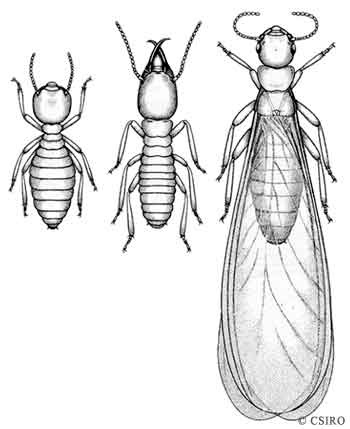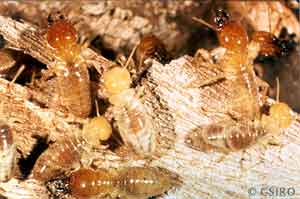|
Isoptera:
termites
Characteristics
Termites
are small to medium sized insects ranging form 3-20 millimetres
in body length. These insects are not often seen although evidence
of their presence is observable in the large mounds they construct
or the damage they do to wood products and structures. Termites
can be distinguished by the following features:
|

Coptotermes acinaciformis (RHINOTERMITIDAE)
|
|
- 2 pairs of
membranous
wings of equal length. Wings are present in reproductive castes
only and shed after mating
- Antennae
about the same length as the head
Termites are
social insects and live in colonies consisting of a queen, sterile
workers and soldiers and winged reproductive males and females known
as alates. Termites are often known as 'white ants' however these
insects are very different from those in the order Hymenoptera
to which ants belong.
Coptotermes
species are widely distributed across Australian and are most easily
recognised by the milky substance that the soldiers produce when
disturbed. All Coptotermes species form large colonies which
likely contain millions of individuals. Colonies may be found in
nests under the ground, in tree stumps, in hollow trees, in living
trees or in conical mounds above the ground. All Coptotermes
species are wood feeders and some are known to cause severe damage
to living trees and other wood including that utilised by humans.
Coptotermes acinaciformis is found in all states in Australia
but only builds mound nests in the northern and south-west areas
of its range.
Life Cycle
Termite
colonies produce a reproductive caste
when they have reached a certain size. These individuals consist
of male and female termites that on warm humid nights usually fly
away from the nest to mate and begin new colonies. After mating,
individual pairs of termites build a new shelter to house a small
number of eggs which will develop into the first workers and soldiers
of the new colony. When this first brood is able to begin enlarging
the new nest and feeding the queen she will begin to lay eggs almost
continually rapidly increasing numbers in the colony. The nymphs
of termites resemble adults. A colony of termites may consist of
over a million individuals.
Feeding
Termites
feed on a wide variety of plant material, which may include wood,
bark, leaves, grasses, fungi, humus or the droppings of herbivores.
Some species forage on the surface at night collecting grasses which
they take back to be stored in the nest. Others more commonly avoid
all light and build protective tunnels to travel between the nest
and their food source.
|

Mastotermes darwiniensis (MASTOTERMITIDAE)
|
|
Habitat
Termites
are found throughout Australia and are usually detected in natural
habitats by their conspicuous earthen mounds, which may be as high
as 3 or 4 metres in some areas depending on the species. Some termites
build smaller earthen nests in trees while others construct a complex
network of subterranean tunnels connecting larger galleries. Wood
dwelling species do not build nests but live within the galleries
they have excavated in the wood they feed on.
Mastotermes
darwiniensis (the giant northern termite) is a large endemic
species which lives in nests in trees and logs. In native environments,
populations are generally small but in built up areas nests can
become very large. In these situations M.darwiniensis becomes
a serious pest of wood including living and dead trees, other wood
products such as building material and even crops. M.darwiniensis
is confined to the tropics but other pest species are found elsewhere
throughout the country.
|


